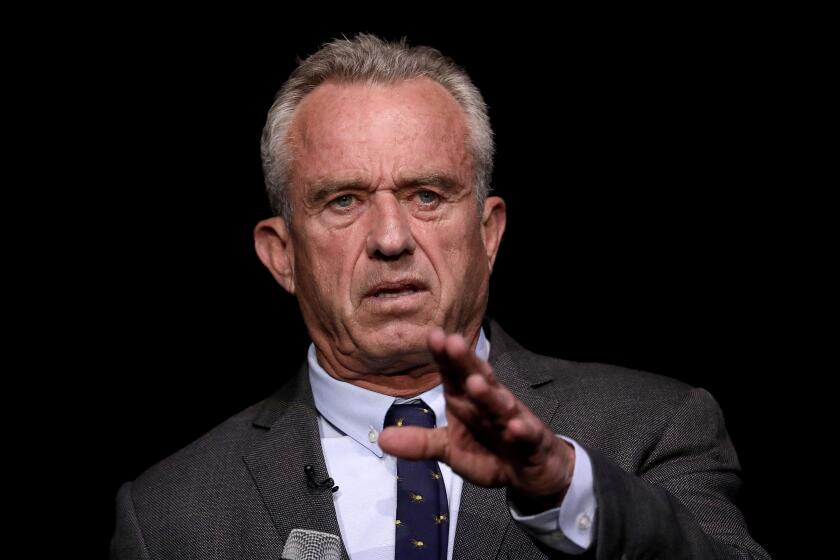Wine prices climb as demand puts squeeze on supplies
- Share via
Ordering some Chardonnay or Cabernet while eating out can sometimes be the priciest part of a meal. And it’s only getting more expensive.
The price of vino by the glass rose steadily over the last six months, according to Restaurant Sciences, an independent firm that tracks food and beverage product sales.
The cause of the costlier buzz? A tightening squeeze on wine inventories — some even call it a shortage — coupled with swelling consumer demand for the alcohol.
“We’re seeing more and more wine lists with nothing under $40 for a bottle,” said Michael Whiteman, president of Baum/Whiteman International Restaurant Consultants. “And that’s a bargain considering what you’ll pay for four wines by the glass.”
The most pronounced surge in wine prices — an 8.4% jump — came in the family dining sector, where the average meal costs $38.50 or less, according to Restaurant Sciences. Wine prices also boomed at the opposite end of the scale, swelling 5.4% at white tablecloth establishments, where an overall check can reach $1,000.
The increase was more muted at casual and upscale casual restaurants, where bill totals range from $38.50 to $122.50. There, wine prices have risen less than 2%.
At Vintage Enoteca, a casual wine bar in Hollywood, co-owner and sommelier Danielle Francois said she’s trying to counter rising prices by selecting wines from lesser-known producers who are more willing to bargain. At her business, wines stay below $14 a glass — anything higher usually goes ignored by customers still dealing with a lackluster economy.
“I’m just not buying those wines that are unaffordable,” she said. “If I can’t get that Napa Cab, I’m going to try the quirky, small label from the Central Coast that’s more flexible.”
And when Francois dines in other eateries, she’s ordering less vino.
“I notice when I go out that my glass of wine is getting more pricey,” she said. “So now I drink a lot more beer.”
Susan Brink, who runs two local Venokado wine shops and serves as wine director at mid-range restaurants such as Dominick’s and Tom Bergin’s Tavern, isn’t perturbed by the price uptick. She attributes it to expected inflationary trends and other business costs.
“Restaurants are in the business to make money,” she said. “It’s like coffee, where it costs 25 cents to make a cup, but they’re going to charge $4 because there’s labor, cleaning and all of those factors that get priced into the markup.”
Wine served in glasses, bottles or carafes delivers $289 million in restaurant sales a year, according to the study, which covered more than 5,000 restaurants. Wine sales from nightclubs, hotel restaurants, fast-food outlets and concession stands were excluded.
Wines such as Sauvignon Blanc and Pinot Noir, once considered good options for value-minded drinkers, have become pricier in recent years, according to another Restaurant Sciences report in December.
The shriveling global supply of wine is contributing to the price bump, experts said.
Vineyards and nurseries are still replanting from the recession, research group IBISWorld said. Workers familiar with vineyard management, grape picking and winemaking are few and far between. Viticulture and oenology training programs are scarce.
Worldwide wine production shrank 6.1% last year to its lowest point since 1975 after poor weather damaged grapes, according to Paris trade group International Organization for Vine and Wine. This year, the industrywide shortage could equal 1.3 billion bottles, according to French wine cooperative Val d’Orbieu.
Even Trader Joe’s Charles Shaw wine, known by its nickname Two-Buck Chuck, got a small price bump in California this year after an 11-year run at $2 a bottle. Underwhelming harvests at source vineyards were deemed to be the culprit.
“The wine industry is trending toward a shortage,” said Rob McMillan, executive vice president and founder of the wine division at Silicon Valley Bank. “But demand for wine is still increasing and has seen growing rates for many years.”
The U.S. is the top wine drinking nation in the world by both volume and value, according to a report this year by Vinexpo, which each year puts on a major international wine exhibition. Analysts there predicted that consumption will continue booming through 2016.
Last year, wine sales in the U.S. reached a record high, rising 2% from 2011 to 360.1 million cases worth an estimated $34.6 billion, according to trade group the Wine Institute.
Even as they approach retirement age, baby boomers are still heavy hitters in the wine drinking community. And wineries have also begun targeting younger drinkers, offering labels with sassier names, relaxed tasting events and easy-drinking wines.
Miracle Mile finance professional Sherry Liu, 27, enjoys the beverage so much that she and her boyfriend drink three bottles a week. But when dining out, the price can be a turnoff, especially since wine has less alcohol content than other drink options, she said.
“A glass of wine could be $14, and it goes down so smoothly that you can drink two glasses in a single dinner,” she said. “A cocktail is $11, sounds far more interesting and, since it’s so much stronger, you tend to nurse one all the way through.”
More to Read
Inside the business of entertainment
The Wide Shot brings you news, analysis and insights on everything from streaming wars to production — and what it all means for the future.
You may occasionally receive promotional content from the Los Angeles Times.











